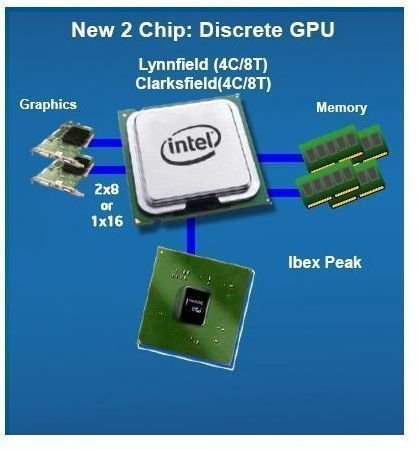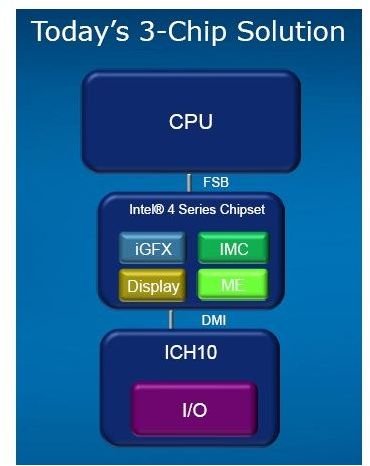Lynnfield, Intel's First Mainstream Nehalem CPU, Likely Debuts Under Core i5 Name in Q3
Intel Is Changing, Try to Keep Up
Intel has recently changed its product roadmaps, delaying 2 core Nehalems (Auburndale and Havendale, for the lap and desktop, respectively) until they can be launched in 32nm trim at the end of the year. Those chips, renamed Arrandale and Clarkdale, will include integrated graphics, but we’re not here to talk about them.
The next big release from Intel will be in the third quarter of this year. It is comprised of the two Nehalem CPUs that were not dropped: Lynnfield (desktop) and Clarksfield (laptop). We will deal with the mobile version and the accompanying Calpella platform in a separate article. For now, we focus on Lynnfield.
The Quad Core Intel Nehalem Lynnfield
The Lynnfield will be the first mainstream Nehalem, following on the successful launch (if disappointing sales) of the enthusiast Core i7 line. Lynnfield is likely to come to market as Core i5, much as Bloomsfield was the codename for Core i7 before the official name was revealed. Like Core i7, Core i5 will be 45nm, have 4 cores, and Hyper Threading, so each core can handle two processing threads. It will also have the same cache design as Core i7, featuring 8MB of shared L3 memory.
The Core i5, again like the i7, has an integrated DDR3 memory controller, but the Lynnfield’s is dual channel instead of triple channel. Unlike Core i7, Lynnfield communicates directly with PCI-e 2.0 graphics, though at a maximum of x16 lanes, which requires splitting them x8/x8 in multiple video card setups.
As the CPU can talk directly to memory and graphics, the northbridge is absent from the Ibex Peak platform on which the Lynnfields will sit. The CPU will use an LGA 1156 socket, not the LGA 1336 used by the Core i7/X58. It communicates with the Series 5 chipset, which is essentially down to providing southbridge functions.
Since the communication between the CPU and chipset doesn’t include graphics, Lynnfield and Ibex Peak won’t include the Quick Path Interconnect found on Core i7. The 2 GB/s Direct Media Interface, currently used to connect north and south bridges on the X-58 and Core 2 Series 4 platforms, will be used instead. We’ll have to wait and see if DMI is up to the new Nehalem’s demands.
Comparing Intel Platforms: Core 2 Series 4, Nehalem X58-Tylersburg, and Series 5 Ibex Peak


Core i5 Lynnfield Performance
We have very, very, little to go on here. Only one test, including three benchmark results has been made public. The test results were originally posted by a user on a Chinese hardware forum, so the nature of the tested part’s source and degree of testing accuracy haven’t been established. The Lynnfield test chip was apparently clocked at 2.13 GHz, which isn’t very impressive. It did, however, turn in better clock for clock performance than the already impressive Core i7. That’s quite a feat when one considers that the Core i5 should be in the price bracket below the Core i7.
The problem is that the Core i7’s speed advantages were largely tied to how well it could handle multithreaded applications, like 3d graphics editing software. If the Lynnfield’s advantages are tied to multithreaded applications, which are usually expensive and run by professionals on workstations, where is the mainstream appeal?
Who Wants an i5?
The basic Intel home or office computer is still in the process of moving to Core 2, which offers plenty of power for those applications. The professional workstation user is most likely to spend the extra cash to go all the way to Core i7, if they haven’t already. Gamers need clock speed more than they need cores, so they really aren’t going to bite on multithreading benefits alone, at least until games can take advantage of it.
Particularly since Lynnfield locks you into the LGA 1156 socket, for which the only announced products are, you guessed it, the Lynnfields. We already mentioned Core i7 using the 1336 socket, and we also mentioned the 32nm Westmere chips with integrated graphics due out by year’s end. We didn’t mention they would be using a third, LGA 1155 socket.
That means if you wanted a 2 core Nehalem, and have a graphics card you wanted to keep, you can either get integrated graphics you don’t need; or you can swallow the price of another 2 cores you don’t particularly need either. Also, no 32nm CPUs have been announced for the LGA 1156 socket through the beginning of 2010, though presumably they will appear down the road. We further discuss the (unfortunately broad) selection of Intel Nehalem CPU sockets here.
